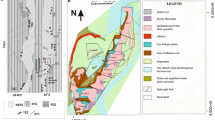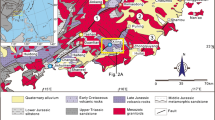Abstract.
The ultrahigh-temperature (UHT) metamorphism of the Napier Complex is characterized by the presence of dry mineral assemblages, the stability of which requires anhydrous conditions. Typically, the presence of the index mineral orthopyroxene in more than one lithology indicates that H2O activities were substantially low. In this study, we investigate a suite of UHT rocks comprising quartzo-feldspathic garnet gneiss, sapphirine granulite, garnet–orthopyroxene gneiss, and magnetite–quartz gneiss from Tonagh Island. High Al contents in orthopyroxene from sapphirine granulite, the presence of an equilibrium sapphirine–quartz assemblage, mesoperthite in quartzo-feldspathic garnet gneiss, and an inverted pigeonite–augite assemblage in magnetite–quartz gneiss indicate that the peak temperature conditions were higher than 1,000 °C. Petrology, mineral phase equilibria, and pressure–temperature computations presented in this study indicate that the Tonagh Island granulites experienced maximum P–T conditions of up to 9 kbar and 1,100 °C, which are comparable with previous P–T estimates for Tonagh and East Tonagh Islands. The textures and mineral reactions preserved by these UHT rocks are consistent with an isobaric cooling (IBC) history probably following an counterclockwise P–T path. We document the occurrence of very high-density CO2-rich fluid inclusions in the UHT rocks from Tonagh Island and characterize their nature, composition, and density from systematic petrographic and microthermometric studies. Our study shows the common presence of carbonic fluid inclusions entrapped within sapphirine, quartz, garnet and orthopyroxene. Analysed fluid inclusions in sapphirine, and some in garnet and quartz, were trapped during mineral growth at UHT conditions as 'primary' inclusions. The melting temperatures of fluids in most cases lie in the range of –56.3 to –57.2 °C, close to the triple point for pure CO2 (–56.6 °C). The only exceptions are fluid inclusions in magnetite–quartz gneiss, which show slight depression in their melting temperatures (–56.7 to –57.8 °C) suggesting traces of additional fluid species such as N2 in the dominantly CO2-rich fluid. Homogenization of pure CO2 inclusions in the quartzo-feldspathic garnet gneiss, sapphirine granulite, and garnet–orthopyroxene gneiss occurs into the liquid phase at temperatures in the range of –34.9 to +4.2 °C. This translates into very high CO2 densities in the range of 0.95–1.07 g/cm3. In the garnet–orthopyroxene gneiss, the composition and density of inclusions in the different minerals show systematic variation, with highest homogenization temperatures (lowest density) yielded by inclusions in garnet, as against inclusions with lowest homogenization (high density) in quartz. This could be a reflection of continued recrystallization of quartz with entrapment of late fluids along the IBC path. Very high-density CO2 inclusions in sapphirine associated with quartz in the Tonagh Island rocks provide potential evidence for the involvement of CO2-rich fluids during extreme crustal temperatures associated with UHT metamorphism. The estimated CO2 isochores for sapphirine granulite intersect the counterclockwise P–T trajectory of Tonagh Island rocks at around 6–9 kbar at 1,100 °C, which corresponds to the peak metamorphic conditions of this terrane derived from mineral phase equilibria, and the stability field of sapphirine + quartz. Therefore, we infer that CO2 was the dominant fluid species present during the peak metamorphism in Tonagh Island, and interpret that the fluid inclusions preserve traces of the synmetamorphic fluid from the UHT event. The stability of anhydrous minerals, such as orthopyroxene, in the study area might have been achieved by the lowering of H2O activity through the influx of CO2 at peak metamorphic conditions (>1,100 °C). Our microthermometric data support a counterclockwise P–T path for the Napier Complex.
Similar content being viewed by others
Author information
Authors and Affiliations
Additional information
Electronic Publication
Rights and permissions
About this article
Cite this article
Tsunogae, T., Santosh, .M., Osanai, Y. et al. Very high-density carbonic fluid inclusions in sapphirine-bearing granulites from Tonagh Island in the Archean Napier Complex, East Antarctica: implications for CO2 infiltration during ultrahigh-temperature (T>1,100 °C) metamorphism. Contrib Mineral Petrol 143, 279–299 (2002). https://doi.org/10.1007/s00410-001-0343-4
Received:
Accepted:
Issue Date:
DOI: https://doi.org/10.1007/s00410-001-0343-4




